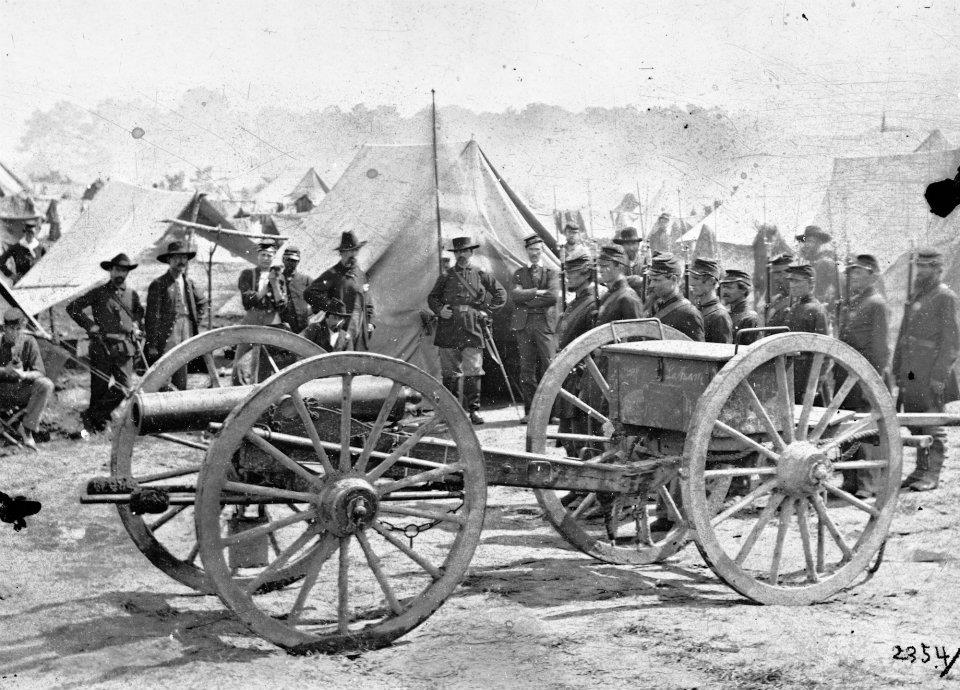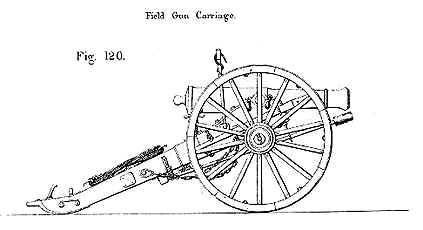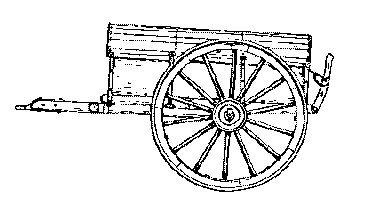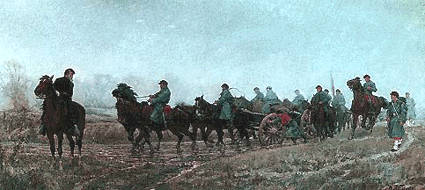Carriages
The carriage performs a number of functions in the operation of an artillery piece, some of them obvious, some not. First and foremost, the carriage holds the cannon in place while being fired, and allows the piece to be aimed. In the case of field artillery, whose mobility is critical, the carriage also allows the piece to be easily moved where it is needed. But transport and firing only begin to describe the functions of the carriage; this seemingly simple mechanical contrivance, through years of trial and error on the march and on the field of battle, acquired a set of refinements that rivalled those lavished on the Parthenon.
The carriage for field artillery consists of two cheeks, bolted together and with the stock. The cheeks support the piece by its trunnions, and in turn rest upon the axle-tree supported by two wheels. The back of the stock or trail rests on the ground. The field carriage dissipates the force of recoil by rolling along the ground, and on firm ground can rear back several feet on firing. On softer ground, the trail tends to dig in, which can cause problems in aiming. The trail terminates in an iron ring called a lunette, which is the means by which it is fastened to the limber. Two pointing rings ahead of the lunette hold a handspike, which provides leverage for aiming the piece. Ahead of the pointing rings are two hooks, around which is wound the prolonge, a length of heavy rope with a ring at one end and a toggle at the other. The prolonge is used to loosely attach the gun to the limber, as when firing while slowly retreating, or for other towing jobs.
| A NUMBER ONE CARRIAGE, SHOWN CARRYING A 6-POUNDER |
|---|
The wheels of the carriage are of very subtle design. Their 14 spokes are dished slightly inward to make the wheels more “springy” on rough ground, and the ends of the axle are tapered downward to correct for this angle, so that the base of the iron-tired wheel is perpendicular to the ground. This dishing outward also improves the cornering of the vehicle and has the salutary effect of throwing mud outward and away from the men and horses following the carriage.
The pre-War system of ordnance called for three models of field carriage: No. 1 for the 6 pounder gun and 12 pounder howitzer, No. 2 for the 24 pounder howitzer, and No. 3 for the 12 pounder gun and 32 pounder howitzer. The Napoleon (model 1857 light 12 pounder) used a No. 2 carriage, as did the 10 pounder Parrott and 3 inch ordnance rifles, all with some minor modifications where needed. There was also some experimentation with carriage design, most notably the idiosyncratic creation of Norman Wiard for his rifles. Wheels for all three of the standard carriages, as well as caissons, limbers and battery wagons, were 57 inches high, and could be easily interchanged. As will be noted, caissons carried an extra wheel, and changing a broken wheel was part of the standard drill for a battery of field artillery.
Limbers and Caissons
The limber for field service is basically a two-wheeled cart, simply an axle, with its wheels, surmounted by a framework for holding an ammunition chest and receiving the tongue. At the back of the axle is the pintle hook, on which the lunette on the trail of the gun carriage can be keyed into place. The result is a four-wheeled cart that pivots on the pintle hook. In theory, the limber chest can be used as a seat for three cannoneers, but after the first few months of the War, it was customary to spare the horses, and cannoneers would ride only when necessary.
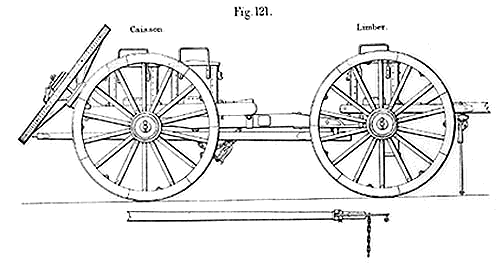 |
| A CAISSON HOOKED TO ITS LIMBER; NOTE THE EXTRA WHEEL AT THE REAR AND THE EXTRA LIMBER POLE SLUNG UNDER THE CAISSON. |
|---|
The caisson is intended to transport ammunition, and carries two chests like that on the limber. It has a stock like that on the gun carriage, terminating in a lunette, so that it can be hooked to a limber for transportation. A caisson with its limber thus held three ammunition chests, which with the chest on the limber hauling the gun carriage would make four in all. The caisson with its drivers and crew would be under the direction of a corporal, who would report to the sargeant in charge of the gun to which the caisson was assigned. The line of caissons for the battery would be under the overall supervision of one of its lieutenants.
The battery wagon, also drawn by a limber, is a long bodied cart with a rounded top, which contains the saddlers’ and carriage makers’ tools, spare parts, extra harness, and rough materials for fabricating parts. The forge is a portable blacksmithy – in this case the chest on the inevitable limber which draws it contains blacksmith tools. Each battery had only one wagon and one forge, and they were expected to accompany the battery wherever it went.
| A BATTERY WAGON HELD A VARIETY OF ACCOUTREMENTS; NOTE ALSO THE FORAGE RACK AT THE BACK. |
|---|
Implements
Each of the cannoneers is equipped with specialized implements, some of which have been mentioned in the description of the firing procedure under Drill. Number 1 uses a sponge/rammer, a large ash staff with a wool-covered sponge head at one end, to be wet for cleaning and cooling the bore, and a rammer head at the other for inserting the charge. Number 3 has a pouch with the priming wire or vent pick, which is a pointed metal rod with a loop at the opposite end, and a vent brush, used to clean the vent and avoid fouling. Number 4 wears a leather primer pouch attached to a belt, and holds the lanyard, a length of cord tied to a wooden handle, with a hook at the free end. Number 5 wears a leather haversack for carrying the ammunition. Numbers 6 and 7, who work together at the chest, have tools for preparing the ammunition, including a fuze punch and a fuze saw. The Gunner carries the sight, which takes various forms depending upon the model of gun; for examples of two different types, see this reproduction brass stadia sight for the 10-pounder Parrott rifle, and this drawing of a pendulum hausse for a six-pounder. For some wonderfully detailed pictures of reproductions of these instruments, see the Chapman & Sons page.
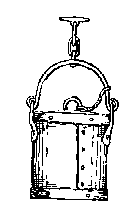  |
Many implements were stored on the field carriages, caissons and limbers. The prolonge, a heavy tow rope, was wound onto two hooks on the upper surface of the trail of the gun carriage, and the sponge-rammers and worms were hung from implement hooks under the carriage. The two handspikes hung from each cheek of the field carriage. The caisson had slots for holding an axe and a pick. The tarbucket (left) hung under the limber and contained the grease for the wheels. The water bucket (right) hung off the axle of the field carriage and held water for keeping the sponge moist.
Artillery Horses
The horse for artillery service should be from five to seven years old (the latter age to be preferred), and should be from fifteen to sixteen hands high.
The saddle horse should be free in his movements; have good sight; a full, firm chest; be sure-footed; have a good disposition, with boldness and courage; more bottom than spirit, and not too showy.
The draft horse should stand erect on his legs, be strongly built, but free in his movements; his shoulders should be large enough to give support to the collar, but not too heavy; his body full, but not too long; the sides well rounded; the limbs solid, with rather strong shanks, and feet in good condition.
To these qualities he should unite, as much as possible, the qualities of the saddle horse; should trot and gallop easily; have even gaits, and not be skittish. The most suitable horse for the pack-saddle is the one most nearly approaching the mule in his formation. He should be very strong-backed, and from fourteen to fifteen hands high.
Gibbon, The Artillerist’s Manual, p. 363.
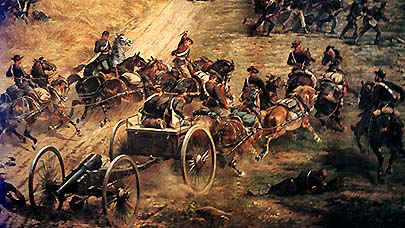 |
| DETAIL FROM THE GETTYSBURG CYCLORAMA PAUL PHILIPPOTEAUX AND ASSISTANTS |
|---|
It is easy to forget that the field artillery was almost as a dependent upon horses as the cavalry. Gibbon held that a battery of six light guns needed 110 horses to take the field, and an even larger number would be required for a battery of mounted artillery. As the principle motive power for the guns, they were a prime target for the opposing force; disabling the horses meant that the guns were at risk of capture. Horses, like the soldiers who depended upon them, were also subject to the rigors of disease, poor rations, and the too-often squalid living conditions of an army camp. The death toll has never been calculated, but the cost of the War in horse flesh was surely enormous.
As their lives and guns so often depended upon their horses, artillerymen were disposed to accept without excessive grumbling the regulations for their care. The bugler would sound stable call after reveille and roll, and water call after breakfast. The same routine for the horses would be repeated late in the afternoon. Morning and afternoon drill also meant a workout for the horses, after which they needed to be walked to cool down, curried, and probably watered again. There were always sick horses requiring care, and those who died requiring burial. (This last was described by John Billings, with the humor that can only be the product of a long passage of time, in his Hardtack and Coffee.)
One driver was assigned to each pair of horses, riding the on (left) horse and holding reins for it and the off horse. Skilled riders were required for this service, which combined the daring of the cavalry troopers with the precision teamwork expected of the artilleryman. Drivers were issued a leg-guard, an iron plate encased in leather and strapped to the right leg to prevent the limber pole from injuring them. The duties of a driver are described in more detail in Field Artillery Positions and Duties, by R. B. Hansen. For a more extended discussion of artillery horses, see James R. Cotner, Horsepower Moves the Guns.

